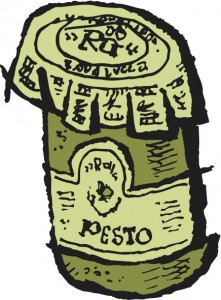Three Tips for Better Pesto
I love going to the farmer’s market this time of year, when the warm breeze jostles the big, leafy bunches of fresh basil and inundates the market with their sweet, spicy aroma. When the scent of basil is no longer enough, it’s time to whip up a batch of pesto. Here are a few of the tricks I have learned to make better pesto:
1. Use smaller basil leaves. In Liguria, home of the original pesto, they always make their pesto with young basil. As basil leaves get bigger, the texture get tougher and the flavor gets duller. Stick to leaves that are no bigger than about an inch and a half long. If you need to use larger leaves, though, stirring in a spoonful of ricotta at the end is a quick way to boost the creaminess.
2. Toast the pine nuts and the garlic. It’s not traditional, but toasting the nuts brings a richer flavor, and caramelizing the garlic makes it sweeter and less sharp. Cook the nuts in a dry skillet over medium heat for 5-7 minutes, shaking frequently, just until brown and fragrant. Then take the nuts out of the pan and slide in a few cloves of unpeeled garlic to brown for a few minutes on each side.
3. Using a mortar and pestle matters. Though it’s more work to make the sauce by hand, the resulting sauce is more velvety in texture, has better color, and stays homogeneous longer. To cut down on grinding time, try ripping the basil into small bits before adding it to the mix. Or not: as Patience Gray notes in Honey from a Weed, “Pounding fragrant things — particularly garlic, basil, parsley — is a tremendous antidote to depression.”





Zingerman’s Art for Sale